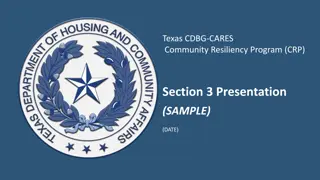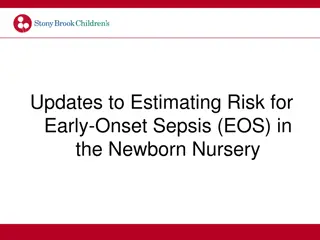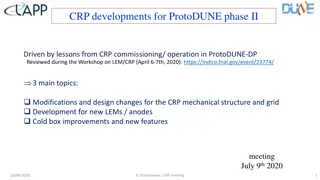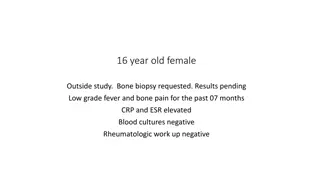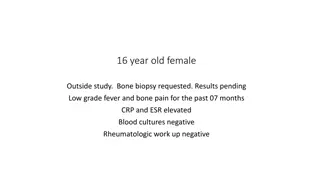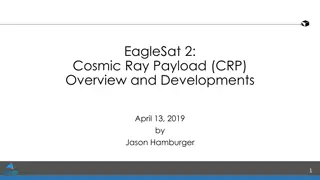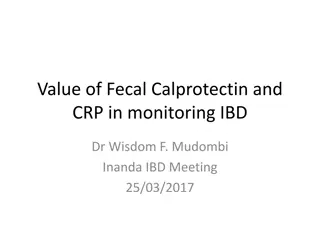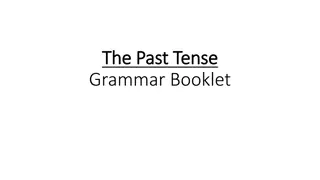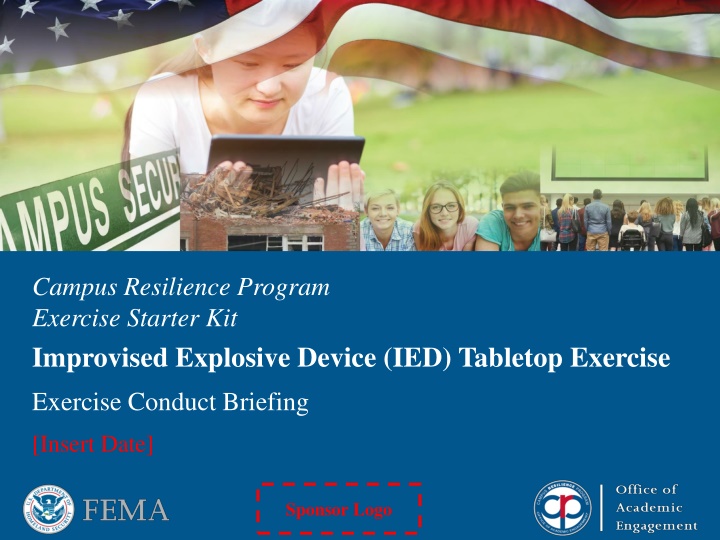
Campus Resilience Program: IED Tabletop Exercise Starter Kit
Explore the Campus Resilience Program Exercise Starter Kit for an Improvised Explosive Device (IED) Tabletop Exercise. This kit provides a baseline document for higher education institutions to evaluate their emergency plans and procedures. Customize the content to align with your institution's needs and logo. Conduct an in-depth assessment with the IED Situation Manual and Facilitator Guide.
Download Presentation

Please find below an Image/Link to download the presentation.
The content on the website is provided AS IS for your information and personal use only. It may not be sold, licensed, or shared on other websites without obtaining consent from the author. If you encounter any issues during the download, it is possible that the publisher has removed the file from their server.
You are allowed to download the files provided on this website for personal or commercial use, subject to the condition that they are used lawfully. All files are the property of their respective owners.
The content on the website is provided AS IS for your information and personal use only. It may not be sold, licensed, or shared on other websites without obtaining consent from the author.
E N D
Presentation Transcript
Campus Resilience Program Exercise Starter Kit Improvised Explosive Device (IED) Tabletop Exercise Exercise Conduct Briefing [Insert Date] Sponsor Logo Sponsor Logo
READ FIRST The purpose of this Exercise Conduct Briefing is to provide a baseline exercise document that institutions of higher education can use to assess their emergency plans, policies, and procedures The sample content contained in this document can be tailored as necessary by filling in all [bracketed content that is highlighted in red] To insert the sponsoring organization s logo, navigate to the View menu and select Slide Master This briefing is to be used in tandem with the IED Situation Manual and Facilitator Guide so any changes made to this briefing will need to be aligned with those documents **Delete slide prior to conduct**
Welcome and Introductions [Name] [Title] [Department/Agency/Organization] [Name] [Title] [Department/Agency/Organization] Sponsor Logo 3
Administrative Remarks Cell phone etiquette Evacuation procedures Restroom locations Sponsor Logo 4
Exercise Schedule Activity [Welcome and Introductions] [Exercise Overview] Module 1: Initial Response Break Module 2: Continued Response Break Module 3: Short-Term Recovery [Exercise Hot Wash] [Closing Remarks] Time [00:00 a.m.] [00:00 a.m.] [00:00 a.m.] [00:00 a.m.] [00:00 p.m.] [00:00 p.m.] [00:00 p.m.] [00:00 p.m.] [00:00 p.m.] Sponsor Logo 5
Exercise Overview Sponsor Logo 6
Exercise Overview Background: This Tabletop Exercise (TTX) is made available through the Campus Resilience (CR) Program Exercise Starter Kits Each Exercise Starter Kit aims to support practitioners and senior leaders from the academic community in assessing emergency plans, policies, and procedures while also enhancing overall campus resilience Purpose: This specific Exercise Starter Kit will provide the opportunity to examine response and recovery operations related to an Improvised Explosive Device (IED) attack. Sponsor Logo 7
Exercise Overview (cont.) Scope: This [insert duration]-TTX is divided into three Modules: Module 1 will examine initial response operations immediately after an IED attack Module 2 will examine continued operations after an IED detonation Module 3 will examine short-term recovery efforts in the hours after an IED attack Each Module will consist of two activities: 1. Scenario Overview: Each Module will contain a detailed overview of the scenario 2. Facilitated Discussions: Participants will engage in facilitated discussions surrounding a set of discussion questions Sponsor Logo 8
READ FIRST The exercise objectives contained in the following slide(s) are provided as sample objectives These can be tailored as appropriate to align with the overarching goals and desired outcomes for the exercise Please note that changes made to these objectives will need to be reflected in the associated Facilitator Guide and Situation Manual for this scenario **Delete slide prior to conduct**
Exercise Objectives 1. Operational Coordination - Assess the ability to establish an effective command structure that integrates all critical stakeholders to ensure campus and community resources are used efficiently to respond to and recover from an improvised explosive device (IED) incident. On-Scene Security, Protection, and Law Enforcement - Evaluate the ability to provide a safe and secure environment for faculty, staff, and students, as well as first responders, during the response to an IED incident occurring on campus. Mass Care Services - Examine processes and procedures to provide and coordinate mass care services to include life-sustaining and human services during the response to and recovery from an IED incident. Public Information and Warning Assess the ability to deliver coordinated, actionable, and timely information to critical partners and stakeholders when faced with an IED incident. Health and Social Services - Examine the ability to protect, restore, and revitalize health and social services at your institution to promote the resilience, independence, health, and well-being of students, faculty, and staff. 2. 3. 4. 5. Sponsor Logo 10
Participant Roles and Responsibilities Facilitator: Provides situation updates and facilitates discussions Players: Respond to the situation presented based on current plans, policies, and procedures Observers: Visit or view selected segments of the exercise without directly engaging in exercise discussions Support Staff: Performs administrative and logistical support during the exercise (e.g., registration) [Insert additional participant roles as appropriate] Sponsor Logo 11
Participating Organizations [Insert Participating Organization] [Insert Participating Sub-Organization] [Insert Participating Organization] [Insert Participating Sub-Organization] [Insert Participating Organization] [Insert Participating Sub-Organization] Sponsor Logo 12
Exercise Guidelines This exercise is being conducted in an open, low-stress, no-fault environment; varying viewpoints, even disagreements, are expected Act in real-world roles for your institution or organization when considering the scenario Decisions are not precedent-setting; this is an open discussion The focus should be on identifying suggestions and recommended actions for improving preparedness, response, and recovery efforts [Insert any additional guidelines that may be relevant to the exercise] Sponsor Logo 13
Assumptions and Artificialities The exercise scenario is plausible and events occur as they are presented Players will use existing plans, policies, procedures, and resources to guide responses There is no hidden agenda nor are there any trick questions The scenario assumes certain player actions as it moves through each phase; players should first discuss the actions stipulated by the scenario Players are welcome to engage in what if discussions of alternative scenario conditions [Insert any additional assumptions or artificialities that may be relevant to the exercise] Sponsor Logo 14
Start of Exercise Sponsor Logo 15
Module 1: Initial Response Sponsor Logo 16
Module 1: Scenario Overview Background [Insert Date and Time] Your institution invites a high- profile political figure to come speak on campus The speaker gains national attention Figure 1: Tweet from a Concerned Student Students, faculty, and staff express concern about hosting the individual on campus Sponsor Logo 17
Module 1: Scenario Overview (cont.) [Insert Date and Time] Event security works to secure the scene on the day of the event Towards the end of the event, an explosion occurs outside of the [insert name of on-campus venue] main entrance Figure 2: Tweet from a Student at the Event 9-1-1 receives calls from students both inside and outside of the building reporting the explosion, fire, smoke, and injuries Social media posts about the explosion begin trending, students flee campus There are confirmed fatalities Sponsor Logo 18
Module 1: Discussion Questions (1/4) Operational Coordination 1. What types of actions does your institution take to prepare for major events on campus? 2. Following detonation, what additional plans, policies, and procedures would your institution use to coordinate your immediate response efforts? 3. How would your institution establish a command structure to coordinate your immediate response efforts? 4. What resource gaps could limit your institution s ability to respond to an IED? 5. [Insert additional discussion questions as appropriate] Sponsor Logo 19
Module 1: Discussion Questions (2/4) On-Scene Security, Protection, and Law Enforcement 1. What types of protective measures (e.g., metal detectors, barricades) would be implemented in advance of the speaking event? 2. In terms of securing the scene following detonation, what are the immediate priorities? 3. How are external law enforcement assets integrated with campus assets? 4. [Insert additional discussion questions as appropriate] Sponsor Logo 20
Module 1: Discussion Questions (3/4) Health and Social Services 1. Are any health and social service resources pre-staged in advance of major events on campus (e.g., medical tents, first aid kits)? 2. What are your institution s immediate health and social services priorities (e.g., evacuation, shelter-in-place) following detonation? 3. What stakeholders would you begin to coordinate with? 4. What critical decisions might need to be made at this point? 5. [Insert additional discussion questions as appropriate] Sponsor Logo 21
Module 1: Discussion Questions (4/4) Public Information and Warning 1. What communication strategies are in place to communicate with students, faculty, staff, and the public in advance of a major event on campus? 2. How and when does your institution issue warnings, alerts, and other emergency messaging? 3. What individual, office, or department coordinates and delivers your institution s public messaging? 4. [Insert additional discussion questions as appropriate] Sponsor Logo 22
Break Sponsor Logo 23
Module 2: Continued Response Sponsor Logo 24
Module 2: Scenario Overview [Insert Date and Time] First responders arrive on scene and begin rescue and triage operations Police find an abandoned duffle bag on scene and request a bomb squad Figure 3: Police Tape at the Scene of the Explosion Witnesses report seeing two suspects flee the scene immediately before the explosion Media outlets have arrived on scene and start providing coverage of the events Social media spreads conflicting information, causing worry and fear Parents begin calling campus administration offices wanting to know if their children are safe Sponsor Logo 25
Module 2: Discussion Questions (1/4) Operational Coordination 1. What new plans, policies, or procedures would be activated at this point to guide response efforts at this point, if any? 2. How would your institution maintain an effective command structure to coordinate emergency response efforts? 3. How do key decision-makers collect information to assess the extent of the situation, to include injuries and fatalities? 4. What resources are currently available? 5. Who are the key external stakeholders that would support response efforts? 6. [Insert additional discussion questions as appropriate] Sponsor Logo 26
Module 2: Discussion Questions (2/4) On-Scene Security, Protection, and Law Enforcement 1. What response plans and protocols would your institution activate at this point? 2. Given the current situation, what strategies would be implemented to attempt to control and manage the scene? 3. How would initial resource needs be prioritized in the event of a secondary attack? 4. Do your campus security and law enforcement personnel have interoperable communications capabilities with external law enforcement personnel? 5. What strategies are in place at your institution to track deployed assets and account for deployed personnel? 6. What plans are in place to balance investigative efforts of an active crime scene with fatality management operations? 7. [Insert additional discussion questions as appropriate] Sponsor Logo 27
Module 2: Discussion Questions (3/4) Mass Care Services 1. What potential mass care challenges does this type of incident pose for emergency managers and law enforcement response personnel? 2. How would your institution address challenges of injured students both on-scene and those fleeing away from the scene? 3. How will your institution account for students, faculty, staff, and campus guests in affected areas? 4. [Insert additional discussion questions as appropriate] Sponsor Logo 28
Module 2: Discussion Questions (4/4) Public Information and Warning 1. How does your institution ensure consistent, coordinated public messaging throughout this phase of response operations? 2. How does your institution ensure timely and accurate situational updates for internal stakeholders throughout the response period? 3. How and when does your institution activate its crisis communications plan? 4. How does your institution notify families, key stakeholders, and the public of fatalities or serious injuries? 5. [Insert additional discussion questions as appropriate] Sponsor Logo 29
Break Sponsor Logo 30
Module 3: Short-Term Recovery Sponsor Logo 31
Module 3: Scenario Overview [Insert Date and Time] Law enforcement personnel release a public statement that they have detained and are questioning two suspects The abandoned duffle bag is cleared of all suspicion Figure 4: Media Gather on Campus Injured victims are transported to healthcare facilities and hospitals in the area, your institution is still compiling information on the number of wounded and how many patients are in each hospital Your institution is starting fatality management operations for approximately [insert number] fatalities Local and national media have acquired cell phone footage of the explosion Worried parents continue to call your institution, some have reached out to the media commenting that your institution could have done more to prevent the attack Sponsor Logo 32
Module 3: Discussion Questions (1/4) Operational Coordination 1. How does your institution coordinate the transition from response to short-term recovery efforts? 2. What plans, policies, and procedures guide your institution s recovery process? 3. What resource gaps could limit your institution s ability to meet these priorities? 4. [Insert additional discussion questions as appropriate] Sponsor Logo 33
Module 3: Discussion Questions (2/4) On-Scene Security, Protection, and Law Enforcement 1. What plans or procedures are in place to manage and secure the scene following the incident? 2. What additional stakeholders would be engaged to assist with these efforts? 3. What plans are in place for managing the presence of media and families on-site? 4. [Insert additional discussion questions as appropriate] Sponsor Logo 34
Module 3: Discussion Questions (3/4) Mass Care & Health and Social Services 1. What are your institution s mass care and health and social services priorities transitioning into the recovery process? 2. How does your institution coordinate, support, and track injuries and fatalities across the campus community? 3. What plans or policies are in place to support affected populations? 4. [Insert additional discussion questions as appropriate] Sponsor Logo 35
Module 3: Discussion Questions (4/4) Public Information and Warning 1. How does your institution ensure consistent, coordinated public messaging throughout the recovery period? 2. How does your institution provide internal stakeholders with timely updates concerning recovery efforts? 3. Who is responsible for monitoring and managing inquiries from affected students, parents, faculty, staff, and alumni? 4. How would you maintain overall brand reputation for an incident involving an IED incident? 5. [Insert additional discussion questions as appropriate] Sponsor Logo 36
End of Exercise Sponsor Logo 37
Exercise Hot Wash Sponsor Logo 38
Hot Wash Overview This Hot Wash aims to capture the following information based on observations made throughout the exercise: Overall strengths Overall areas for improvement Major takeaways and action items Sponsor Logo 39
Closing Remarks [Name] [Title] [Department/Agency/Organization] [Name] [Title] [Department/Agency/Organization] Sponsor Logo 40
Adjournment Sponsor Logo 41
Campus Resilience Program Exercise Starter Kit Improvised Explosive Device (IED) Tabletop Exercise Exercise Conduct Briefing [Insert Date] Sponsor Logo Sponsor Logo


